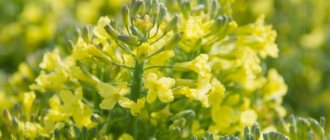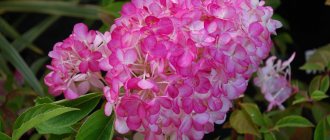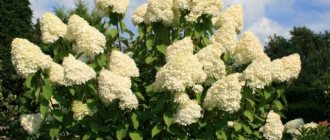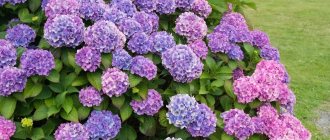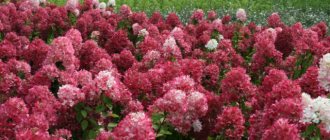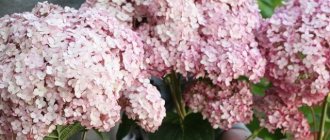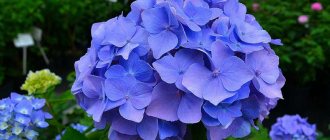Characteristics of the flower
Large-leaved hydrangea is considered a popular garden species, which belongs to the ornamental perennial shrubs 1-3 m high. Scientifically, hydrangea is called hydrangea, that is, a “water vessel” because it loves moisture. In warm weather, the shrub is covered with large egg-shaped leaves with pointed edges.
Hydrangea begins to bloom in June-July and ends in September-October. At this time, the ends of the branches of the plant are decorated with lush spherical volumetric inflorescences. At first the flowers are colored with a greenish tint, but gradually acquire a bright white or pink color. Blue color is less common. At the end of summer a slight yellowish tint appears.
They found that the color change is affected by the acidity of the soil, but only in large-leaved hydrangea. So, by increasing or decreasing the acidity of the area under the hydrangeas, you will be able to grow flowers of the desired color.
How often to water?
Hydrangea is a moisture-loving plant; its full growth requires abundant watering . When growing a flower on the street, such events should be carried out at least 2-3 times every 7 days, spending from 30 to 50 liters of well-settled water on each bush.
At the same time, it is necessary to take into account the temperature outside; when it gets colder, the frequency of watering can be reduced to once a week. Plants growing indoors are watered as the top layer of soil dries.
It is necessary to add compositions to the soil to give the petals a particular shade after moistening with clean water once every 2 weeks.
How is soil acidity determined?
The amount of acidity (contained salts with acids) in the soil is usually indicated by indicators 0-14:
- strongly acidic environment indicator – 0-4.4;
- An environment with values of 4.5-5.4 is considered acidic;
- indicator of slightly acidic soil – 5.5-6.4;
- from 6.5 to 7 – neutral indicator at 6.5-6.9;
- starting from 7, the soil is considered alkaline.
To determine soil acidity, use:
- Vinegar essence. Take a spoonful of soil and pour vinegar (3-4 drops). If the vinegar boils, the soil is alkaline. If the reaction is weak, it is clear that the acidity is neutral. If the reaction does not occur, this indicates acidic soil.
- Grape juice. A lump of earth is dropped into a glass of drink. If the color of the juice has changed and gas bubbles have appeared, the acidity is normal.
- Using currant or cherry leaves. You will need boiling distilled water, which is poured into a handful of leaves. Throw 1-2 handfuls of soil into the cooled infusion. If after 1-2 hours the water turns red - the soil is acidic, if it turns blue - slightly acidic, if it turns green - the area has a neutral environment.
- Litmus paper. Pour distilled water into a glass and place a bundle of cloth with a spoonful of soil in it. When the soil becomes cloudy, lower the yellow litmus strip. The appearance of red color on paper indicates an acidic environment, and blue-blue indicates a neutral environment.
- Some determine the acidity of the soil of a site visually. Strongly acidic soil has a rusty-red hue. If the soil is acidic, puddles of water become covered with a thin, iridescent film.
- Only a special device will give an accurate indicator.
When planning to control the color of hydrangea, the acidity of the soil is determined before planting the shrub. Prepare appropriate substrates and fertilizers in advance, and also maintain the soil acid level.
Factors affecting color
The color of the inflorescences is determined by:
- hydrangea variety;
- soil composition and acidity.
Hydrangea Weems Red - description of paniculate garden hydrangea
To influence the shade and know how to change the color of hydrangea, you need to process it immediately after planting. Then the color of the buds will be brighter and more saturated. In this case, red and purple buds appear.
The composition of the soil and acidity can be changed independently, using various additives and turning to traditional methods.
Effect of soil acidity
Soil tends to react when it interacts with water or saline solutions. It is determined by the presence of hydrogen ions in the soil and can be:
- neutral;
- acidic;
- alkaline.
Note! With an acid reaction, hydrangea flowers turn blue. The shade changes depending on the concentration. The inflorescences can even be bright blue. If the reaction is alkaline, the hydrangea turns pink.
Determination of soil acidity
Acidity can be determined using special devices or test strips. Their color changes upon contact with the ground, depending on its reaction.
Agents for changing acidity
There are mini testers that will help determine acidity when immersed in the soil. They are usually equipped with a scale with values from 4 to 8. A neutral reaction keeps the Ph value around 7. A decrease indicates that the soil is acidic, an increase indicates an alkaline environment.
Acidity measuring device
Digital and electronic instruments for determining soil reaction have a wider range of values that are displayed on the screen.
There are special professional kits used for complete soil analysis. They contain the liquid reagents needed to perform the tests and detailed instructions.
Acidity is determined using litmus paper. It is placed in a container with water and a soil sample. They are taken in a 1:1 ratio. The change in color indicates acidity.
Traditional methods
There are traditional methods for determining acidity using improvised means:
- You need to take a soil sample and put it in a jar. Pour vinegar or hydrogen peroxide on top. If a reaction appears in the form of foam or hissing, then the soil is alkaline. The absence of changes indicates increased soil acidity;
- Grind the blackcurrant leaves and place them in a jar of hot water. After a few minutes, place a soil sample inside. The water will change color. When a pink tint appears, the environment is said to be acidic. The more saturated it is, the higher the reaction. If the water turns green, the soil is neutral; when it turns blue, it is alkaline.
Color changing watering agents
The soil in the middle zone in garden plots is usually neutral or slightly acidic. It is suitable for most plants, including pink hydrangea. For a blue flower, it is necessary to use additional products to preserve the color. Otherwise it will turn pink or dirty crimson.
Important! To obtain a blue pigment, the soil must have soluble aluminum. When the soil is characterized by low acidity, the flower cannot obtain an important element from it. Therefore, its additional application is required.
Aluminum sulfate is used at the rate of: 500 grams per 1 square meter. You can purchase special aluminum sulfate designed to be dissolved in water. Each time you water, it is added to the container.
How to maintain soil acidity for hydrangeas
Blue-hued flowers will require acidic soil with soluble aluminum available to the plant. The soil is fertilized with high-moor peat or sulfur. Regular watering using aluminum sulfate is observed. For mulch, use pine bark or pine litter.
Fertilize with fertilizers containing potassium (high%), phosphorus (low content), nitrogen (average content in the composition). Some gardeners add coffee grounds to the soil to help hydrangeas absorb aluminum. For watering I use soft rainwater so that the blue color does not change to pink shades.
Pink flowers appear when the soil acidity is 6.0. As the acid content increases, the flowers acquire blue or purple hues. Sometimes blue and pink inflorescences can be found simultaneously on one bush.
Pink flower caps will grow in an alkaline and neutral environment, with an acidity greater than 6.5. This environment will prevent aluminum from getting inside the plant. Deoxidize the soil with chalk, limestone or dolomite flour. If the acidity exceeds the indicators, the plant will develop chlorosis.
In the fertilizer for pink hydrangea: nitrogen and phosphorus - high concentration, potassium - low concentration. The pink flowers are produced using crushed eggshells, which reduce the acid content, making it difficult for hydrangeas to absorb aluminum.
Adviсe:
- Change the soil in advance, before the plant blooms. The right time is late autumn or early spring.
- The color change will not happen in 2-3 days, it will take not one week or even one month, but 10-12 months.
- Blue flowers are easier to replace with pink buds.
- It is recommended to change the color when 2 years have passed since planting.
The color of hydrangea, like litmus, shows the level of acid-base environment of the soil. In slightly alkaline or neutral soil, hydrangeas with pink flowers grow; blue and blue flowers indicate increased acidity.
Which hydrangea can change color?
Let's start with the fact that we can change the color of only one type of hydrangea - large-leaved or garden (Hydrangea macrophylla).
Other species are not inclined to change colors to please the gardener. There are varieties that change shades during development, but this cannot be influenced artificially. For example, the variety of hydrangea paniculata Pink Diamond blooms with white panicles in the summer, which turn pink by themselves in the fall.
But you can experiment with large-leaved hydrangea. And make the pink variety blue, and the blue variety pink. This is because their color is due to the presence of special substances in the cell sap of the petals - anthocyanins. Depending on the environment in which anthocyanins are located and what they combine with, the color of the petals occurs in pink, blue or purple tones.
As for white hydrangeas, you won’t be able to change their color to pink or blue, no matter how hard you try. Their petals do not contain the “variability” pigment (anthocyanins), so they will remain white regardless of any adjustments.
The same hydrangea bush can bloom with both pink and blue flowers.
Why do hydrangeas need aluminum?
In a neutral and alkaline environment, hydrangea does not absorb aluminum, which is why hydrangea flowers are pink. At a low pH, the element becomes dissolved and is absorbed by the plant, causing the flowers to turn blue.
After an acidity level of 5.5 or more, aluminum dissolves with difficulty, and hydrangea is not able to absorb it.
Thus, the coloring of flowers depends on the plant variety, pH level, presence of aluminum and fertilizers. Sometimes, getting used to a new place, the bush independently changes the color of the inflorescences and even dresses up in 2-3 shades. To maintain the emerging color, gardeners choose proper watering, combining it with other agricultural practices.
Blue hydrangea in the garden
How to paint a hydrangea so that the blue flower acquires a rich blue tint:
- You need to take care of it, creating comfortable conditions. The intensity of color is affected by environmental temperature, humidity and the general condition of the plant;
- Regular feeding and maintaining the required level of acidity will make the inflorescences bright and colorful;
- Iron salts will help the shade change and make it richer. Such additives can “touch up” a shrub, making it more attractive.
It is also important to periodically add a solution of aluminum sulfate to the soil in the garden, acidify the soil and monitor watering and lighting conditions, and feed during the flowering period.
The effect of fertilizers on the color of hydrangea
To maintain the required level of acidity, the soil is fertilized with nitrogen and phosphorus elements.
In order to change the color of the hydrangea, aluminum salts are added to the water for irrigation.
Recipes for watering compositions:
- Aluminum-potassium alum (5 g) per 1 liter of water.
- Dissolve 10 parts nitrogen, 5 parts phosphorus and 20 parts potassium.
- Regular watering with fertilizer containing potassium sulfate (15 g of composition per 1 liter of water). Flowers and leaves are not wetted.
- Irrigation with organic acid. It is allowed to take acetic acid, oxalic acid or another type.
- Softening settled but hard water for irrigation with lemon juice. A day before watering, apply peat to the roots.
It is necessary to irrigate carefully so that the liquid does not fall on the leaf plates. Before irrigation, the soil at the roots is soaked with clean water.
Color Changing Technology
Start of the process
Why do hydrangeas have pale leaves - what should I feed them with?
Before you start painting hydrangeas, you need to determine the acidity of the soil. To do this, use special means or turn to folk methods. If you want to have hydrangeas of different shades, experienced gardeners recommend growing them in different containers. This makes it easier to maintain the soil acidity required for each color.
Hydrangeas in pots
Soil testing
Sometimes the soil does not need to be tested. The appearance will tell about its properties:
- red tints on the surface, reminiscent of rust, indicate that it is highly acidic;
- after watering, a film forms on the water, which shimmers in the sun, which means the reaction is acidic.
If there is a device that allows you to determine the exact value of soil quality, then you can predict the color of the plant in the future. Provided no additional funds are deposited:
- pH about 7.5 – bright pink inflorescences;
- pH less than 4.5 – a blue tint will remain or appear;
- pH in the range from 5.5 to 6.5 - the flowers will become purple or pink and blue on the same bush at the same time, you will get colored hydrangea.
Application of drugs
There are several ways to change soil acidity:
- When planting, add acidic peat, for example, pine bark, to the top layer;
- Feed with special fertilizers that acidify the soil;
- Mulch with peat and pine needles. This means that you need to add these materials to the surface of the soil in order to change its properties in this case. Thus, mulching is also used to protect against pests and diseases, and not only natural materials are used, but also artificial ones, which are crushed to the desired size.
Watering with potassium permanganate
Watering with rose water will help the hydrangea absorb aluminum, and the plant will be decorated with blue flower caps. Besides:
- potassium permanganate is useful for the prevention of fungal diseases;
- will help establish flower stalks and enhance flowering;
- will support the pH value;
- will strengthen the stem and wood, increase flexibility.
Fertilizer application
How to prepare hydrangea for winter
There should also be high-quality fertilizing of flower crops. What is the best way to water blue garden hydrangea? Complex mixtures should be taken where the main element is potassium. Nitrogen can be added, but in small quantities.
Additional Information! A spectacular flower should not receive phosphorus-containing fertilizers, since phosphorus prevents the metal from disintegrating in the soil. Accordingly, aluminum will not get into the plant.
How to water hydrangea so that it changes color, folk recipes
Potassium permangantsovka
The addition of this substance allows you to increase the digestibility of aluminum, which contributes to the formation of blue buds, which look great both in pots and flower beds, and in bouquets. Potassium permanganate has other positive effects on hydrangeas:
- preventing the development of fungal diseases;
- assistance in planting flower stalks, enhancing flowering;
- maintaining the pH value within the limits required for the plant;
- strengthening the stem and wood, increasing their flexibility.
A bright crimson solution of potassium permanganate is not recommended for use, since it will only cause fragmentary painting, which will cause loss of decorative properties. An overly concentrated product will cause burns to the foliage and root system.
Important! All potassium permanganate crystals must dissolve in water. The remaining crystals cause severe burns.
Varieties that change color
Among the common types of hydrangea are:
- Tree-like;
- Paniculate;
- Oakleaf;
- Garden, etc.
Each of them looks gorgeous, but only garden hydrangea has the ability to change the shade of the petals.
Garden hydrangea
The more common name is large-leaved. The flowering shrub stretches up to 1.4-1.8 m. The shape of the bush resembles a ball. The peculiarity of this species is its bright emerald leaves. They are large and oval. There are nicks. The caps of the inflorescences are fleshy. The diameter of each inflorescence is about 15-20 cm. The shoots begin to become woody only after a year. Because of this feature, garden hydrangea needs shelter for the winter. Fortunately, dwarf varieties have now appeared. They are intended for breeding in apartments.
Note! The uniqueness of hydrangea is that it grows well both in acidic soil and in slightly acidic, neutral and alkaline soil.
Among the varieties of large-leaved hydrangea, there are those that can change color, depending on the acidity of the soil and the content of aluminum metal in the soil. The color changes due to the pigment substances anthocyanins. They are the ones who react to soil pH. In addition, such flowers contain another pigment matter - delphinidin-3-monoglycosite. The pigment also reacts to the conditions in which the flowering crop is grown, in particular to the presence of aluminum in the soil.
In order for hydrangea to bloom blue, the gardener is recommended to buy the following varieties of large-leaved flowers:
- Endless summer;
- Blue Wave;
- Masya;
- Renata Steiniger and others.
All these varieties have a long flowering period. The first inflorescences are observed in mid-summer. Flowers delight summer residents before frost sets in.
Watering procedure for blue hydrangea
The most common question from gardeners is: how to water hydrangea so that it changes its color to a blue tint? It is a well-known fact that blue color is influenced by aluminum. Therefore, it would be natural to ensure that this metal is present in the ground to change the shade of the plant. It is worth noting one important detail: it is strictly forbidden to change the color of already formed flowers.
All procedures associated with changing shade occur in early spring, or at the time of planting. Moreover, you need to use such forms of the substance that they can easily penetrate the soil and be absorbed into the roots of the plant. Therefore, aluminum sulfate, which dissolves in the irrigation liquid, is most often used. This is done like this: 25-25 grams of aluminum sulfate are dissolved in one ten-liter bucket. You need to water the plant with this solution, with two buckets of this mixture per bush. You can also use dry aluminum sulfate. To do this, it is buried in the ground near the bush, approximately 250 grams per half meter square. After this action is completed, the soil is watered abundantly and mulch is laid out, in the form of dry grass, pine needles or sawdust.
Burnt alum for this plant is a good remedy. They appear to be volcanic minerals. They contain alkaline potassium and aluminum. Simply put, it is potassium aluminum sulfate. There is also another type of this substance - potassium alum for these shrubs. In principle, it is the same sulfate, but with water molecules. Externally, this substance looks like a white crystalline powder. It dissolves very well in liquid. Both of these substances have the same use, but differ in solubility in liquid (burnt ones dissolve less well).
To use alum for this shrub, you need to: dissolve 15 grams of alum in five liters of liquid, and also, as an option, bury dry powder around the root of the plant, then the consumption will be approximately 150 grams per half square meter. It should be remembered that the procedure for adding aluminum to the soil is required every 2-2.5 weeks with the arrival of spring. At the moment when the inflorescences begin to change their shade to blue, this procedure should be stopped for a certain period of time.
Useful care tips
Once the color of the hydrangea has been changed to blue, it is important to maintain it. To do this, soil acidity is kept at 4-5 pH. They also continue to water it infrequently, but still, with products containing aluminum.
Experienced gardeners advise not to experiment with the coloring of petals every year. A sharp change in acidity causes stress in plants. Therefore, it is best to plant several flowers in the garden, the shades of which will vary.
In order for hydrangea to bloom blue, it is important to organize the correct comprehensive work. It is a long process that will help achieve high-quality results. However, novice gardeners should not worry if they were not able to completely change the color the first time. Still, hydrangea is one of the flower crops that is quite difficult to care for.
Soil acidity
In addition to the presence of aluminum in the soil, the changing color depends on the acidity of the soil. For hydrangea to bloom blue, the pH must be below 5.5 pH. That is, the blue color is caused by acidic soil. If the pH level is 5.5-7 (neutral and slightly acidic soil), then the flowers will be light. If the pH is above 7 (alkaline earth), the petals will appear pink.
How to determine acidity
- The popular method of determination is using ordinary chalk powder. It's not difficult to do. You need to take 1 spoon of garden soil. Mix it with 2.5 tablespoons of warm water. Add half a teaspoon of chalk powder to the mixture. Mix everything and pour into a bottle with a narrow neck. Put a rubber fingertip on the bottle. There should be a minimum of air in the bottle. The mixture is shaken well and left for 15 minutes. If the fingertip is inflated, it means that the soil in the area is acidic. If there is air in it, but not much of it, it means the soil is slightly acidic. If nothing happens, then the soil is neutral.
- Garden retail outlets sell special litmus papers. They come with colorful instructions. It indicates which color of paper corresponds to a certain type of soil. All new pieces of paper are neutral or yellow. They must be immersed in a mixture of water and soil. In this case, take one spoon of soil, 4 spoons of water.
- The device. Such a device most accurately determines the pH value. But the device is not cheap.
- Another simple way to determine acidity is by looking at weeds. It is known that acidic soil is attractive to fern, plantain, cornflower, dandelion, chamomile, and sedge. Neutral ones are chosen from nettle, sow thistle, shepherd's purse, and quinoa. Thyme, mustard, chicory, and spurge grow in soil with a pH level above 7.
How to change acidity
Before you change the color of the hydrangea to blue, you need to make the soil acidic. The best pH is 4-5.4. If it drops less, it could have a negative impact on the crop.
Acidification work is carried out in the area next to the hydrangea bush. It is necessary to make a 30 cm layer of soil acidic. If planting is just planned, then the soil mixture intended for the planting pit is made acidic. You can make it sour using fresh sawdust and peat.
Acidify the soil for hydrangea
If acidification of the soil of an already planted plant is required, then citric or acetic acid is used. Use 2 tablespoons of citric acid per 10-liter bucket of water. 9% vinegar will be needed for the same volume of water 100 grams. Such procedures are organized several times a season, starting in early spring. Mulch in the form of pine needles, sawdust, high peat, and bark can help with oxidation.
Large-leaved hydrangea, care
Large-leaved hydrangea has its own characteristics, and it is much more difficult to care for than the previous two. But I have already shared my bushes with so many friends, relatives and acquaintances. And the overwhelming majority of them do not regret at all that with the appearance of this hydrangea in the garden, more trouble has been added - the flowering pays for all the costs. So what is this plant?
It is worth distinguishing between the garden and indoor varieties. The one sold in flower shops is very heat-loving and will have difficulty growing and blooming in the garden. You need to buy large-leaved hydrangea at garden centers.
Large-leaved hydrangea blooms on last year's shoots . This means that the buds from which branches with flowers at the top will appear must overwinter. And these buds are located not at the base of the bush, but closer to the top. The more branches and preserved buds there are on the bush, the more abundant the flowering.
Accordingly, large-leaved hydrangea cannot be pruned at all (except for dried branches), and in order for the buds to survive , they should not be exposed to frost. That is, this hydrangea must be carefully covered for the winter . And one more consequence: you won’t be able to cut this hydrangea for bouquets - the more buds you leave, the more magnificent it will bloom next year.
It is also important that large-leaved hydrangea loves shade and moisture more than others. In a sunny place, delicate inflorescences dry and burn, and also fade faster. Even in strong shade, this hydrangea blooms quite well, and in partial shade it is simply an ideal place. At the same time, it rarely needs separate watering (unlike, say, rhododendrons), only in very dry summers.
